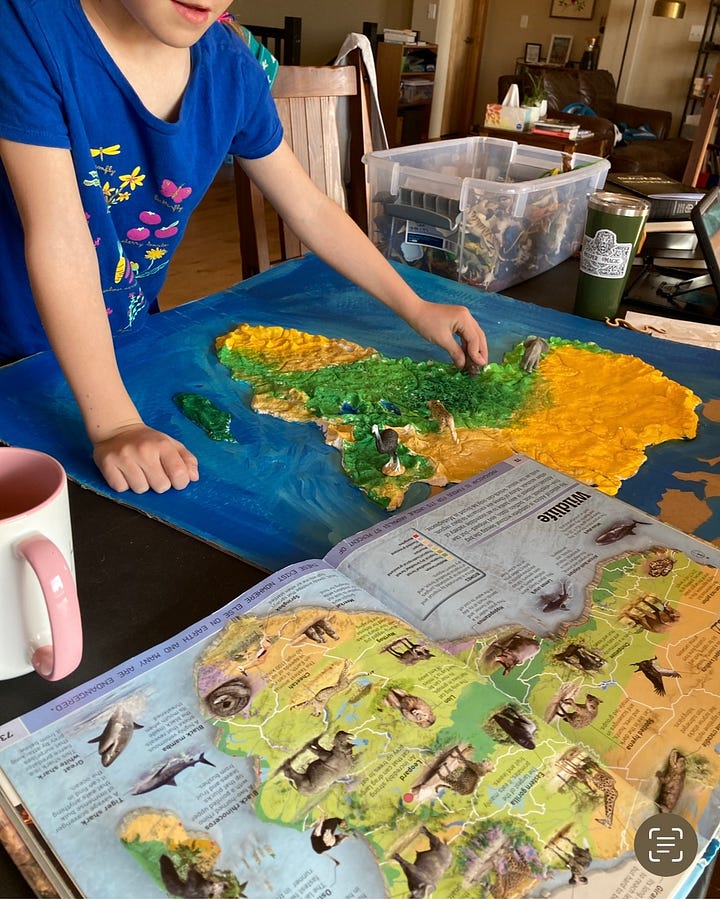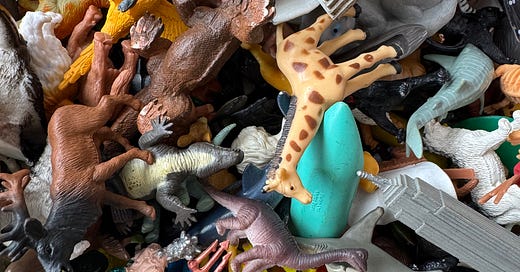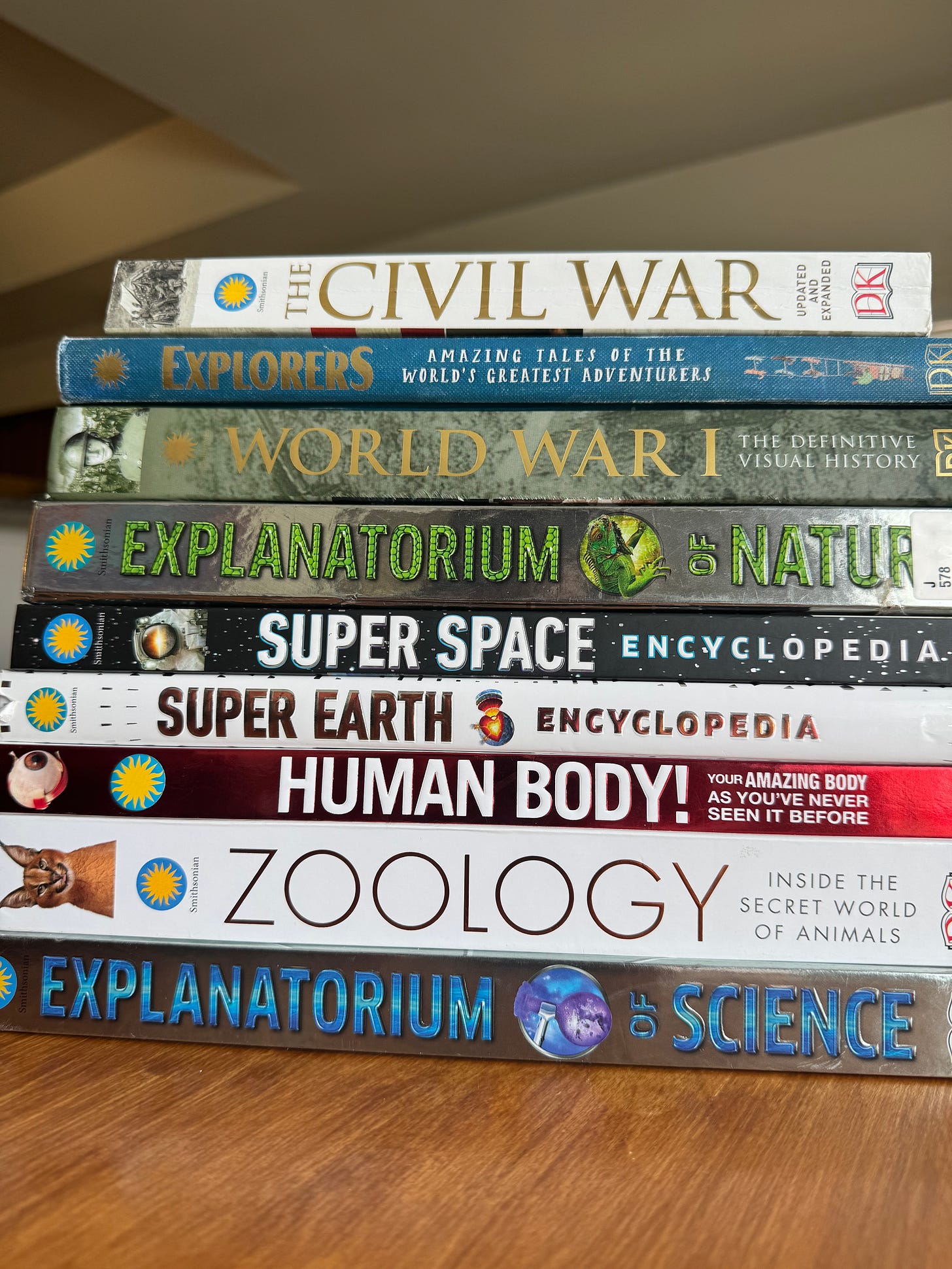I thought it’d be fun to share some of my favorite homeschool resources but there are just too many to fit into one post. I’m not going to create categories (top games! top art resources!) because my brain doesn’t work that way and when I try that, I never publish them because I get writing paralysis.
To take the pressure off of zeroing in on my top faves, I’m just going to drop a post now and then that contains few of of my favorite things that we’ve used in our homeschool.
Without further ado here are a few of my favorite things, in no particular order, all of them tried and true.


Toob Animals
Before we began homeschooling, I had a neighbor whose daughter, Megan, was an animal lover. This sweet girl had loads of these Toob animals which she and my boys would play for hours. Before we moved away, Megan let my boys choose a bunch of animals to keep so they’d remember her. And we’ve been collecting them ever since. Birthdays, Christmas, Easter baskets would often contain these sets. We don't have them all (I wish we did!) and some of them are getting harder to find (check Facebook Marketplace, we’ve scored some there, too!)
Why are they my favorite? Because you can use them in a million different ways.
SCIENCE:
Habitats and biomes: Create dioramas or shadowboxes (whatever these crazy kids call them these days) and fill them with the appropriate animals.
Classification: Make an animal kingdom chart using the actual toys instead of the drudgery of writing it all down.
Grab an atlas and match the animal to the country/region/environment (oh look! Geography!)
Freeze dinosaurs in a block of ice and excavate them!
Group them by characteristics/traits/defenses etc.
MATH:
Group the animals by colors.
Put a bunch of animals in a grab bag. As you pull out an animal, note something about it (color, beginning letter, etc.) and create a category on paper or a white board. Make a tick mark each time an animal fits a category (or multiple!) Then graph the results and talk about your findings.
Beginning math: So much more fun adding/subtracting animals you can pick up and rearrange instead of just what’s on paper.
Exposure to more Algebra: You can add x + x (cats to cats, mammals with mammals) but not x + y (cats to dogs) or maybe you can add cats and dogs because both are mammals but you can’t add them to alligators because it’s a reptile.
Fractions: How many birds do you have total? How many of the whole group are blue? Make a fraction. Etc.
Life cycle of animals!
LANGUAGE ARTS:
Phonics practice: Much like you did with the graphing, put the animals in a bag or in box of rice and as you pull them out one by one, make the sound, discuss the first letter. You can do this with the ending sounds, too.
Early spelling/phonics: curate animals that have letters you can use for spelling words. Work on sounds and spelling words using the beginning sounds of the animal to spell the word.
Act out a story about the animals — write one if they are so inclined. All the pretend play they do with the animals is a form of Language Arts, it’s story telling, narration, and verbal communication. My kids played and played like this on their own but they also would retell stories and books from our learning.
Toob animals are great because they can be used in water, sensory play, outside, inside, and wash easily. The possibilities of how they can be used are endless.
DK Smithonian Encyclopedias
Oh my goodness, I love these books.
Full of gorgeous illustrations and bite size information. But don’t let the “bite size” fool you! They are full of complex ideas and go deep in their information.
When my kids were little they were more visual candy in book form and they’d pour over the stunning photographs. Your kids grow into not out of these books.
Great reference resource. I grab these books to clarify or expand a subject mid-lesson.
Sometimes works of art pop up in the science encyclopedias which make for awesome rabbit trails. They’re full of surprises, you never know what you might find browsing the pages.
We’ve also found plenty of experiments in their pages that can be done at home.
They can be pricey so look for sales or try to find them used. They’ve become go-to resources for just about any subject.
Scrap Paper
I know this sounds ridiculous, but here me out. There are always printing mess ups drawing mistakes, and paper everywhere. Maybe it’s just my house. We have a scrap paper drawer which gets used all the time. Here’s what we do.
We write rough drafts, lists, or notes on the backs of the mess up. Writing on a piece of trash can take the pressure off of writing because it’s already imperfect.
Do you ever use glue? We get scrap paper out and then put it under what we’re gluing. If the glue drips or the glue stick goes off that tiny sliver, it’s fine. It’s just on the scrap paper which we can recycle later on.
Painting something small? Stick it on the scrap paper and protect your table. Or, we sometimes use scrap paper in between sketch book pages to keep from smudging or staining.
Paper airplanes? Scrap paper.
Pretend play (money, tickets, games, etc.)? Scrap paper.
Doodling to keep hands busy? Scrap paper.
I’m telling you, scrap paper is an invaluable tool to add to your homeschool toolbelt.
When the dog bits and the bee stings, I simply remember my favorite homeschool things and then I don’t feel so bad!
What are some of your favorite things?







I love all of love all of these and wholeheartedly agree!
Those are my favourite things too!! Love the toob animals. So many uses (and learned some more here), my daughter has them out almost daily.